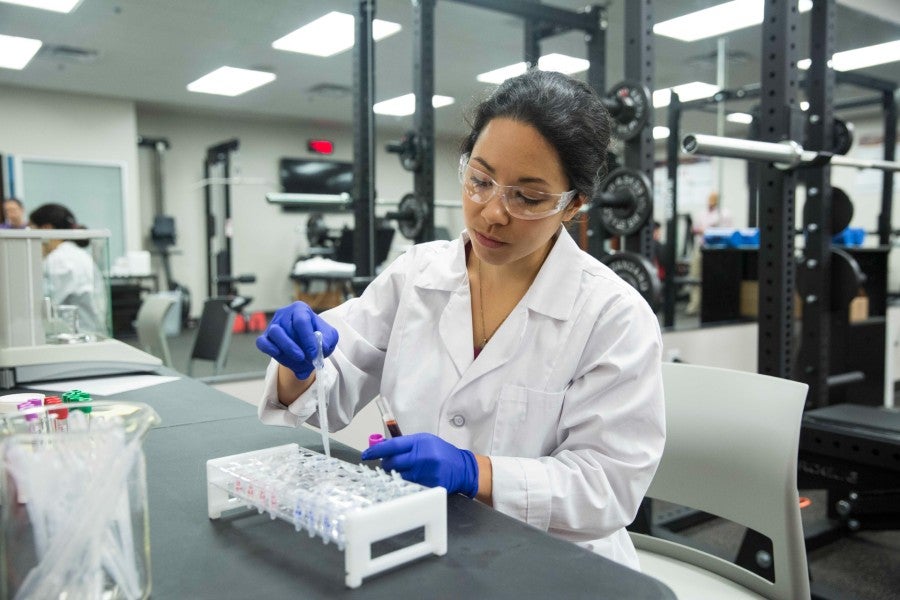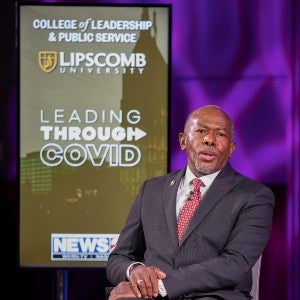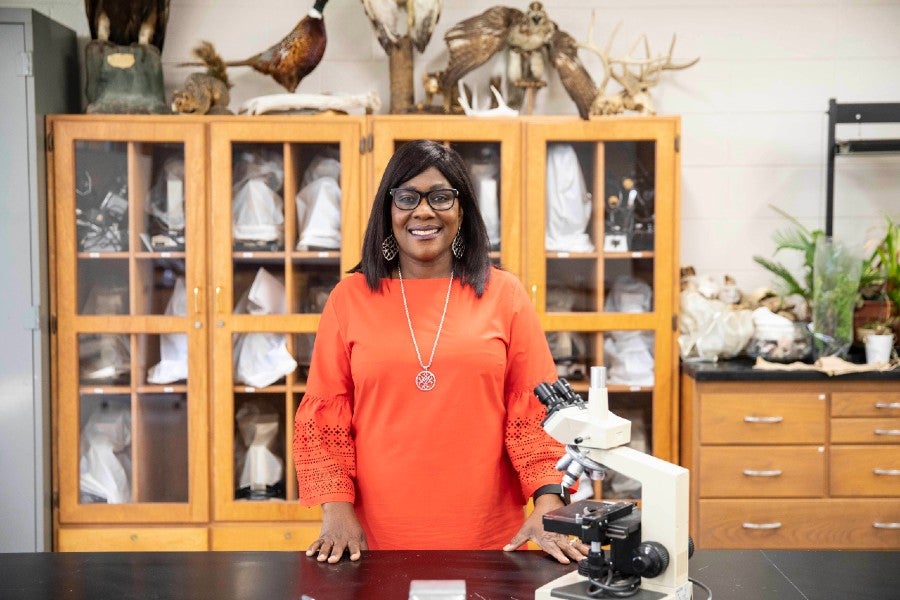10th annual Student Scholars Symposium highlights decade of growth
Lipscomb University held its 10th annual Student Scholars Symposium on April 8, with over 300 undergraduate and graduate students participating.
Logan Butts |

Kinesiology Research
Lipscomb University held its 10th annual Student Scholars Symposium on April 8, with over 300 undergraduate and graduate students participating.
The day-long event celebrates Lipscomb’s diversity of academia by providing a showcase for the student body’s scholarly research and creative works, including oral and visual presentations; readings and performances of original poetry, music and theater; and exhibitions of artistic and scientific work.
Sponsored by the Office of the Provost, the event features students from a wide variety of majors, programs, and colleges across campus.
“The diversity of the majors represented has continued to grow over the years,” said Florah Mhlanga, the program’s director. “The diversity of works presented has continued to increase. I'm seeing an increase in the systemic integration of research and creativity into the undergraduate curriculum. Many students present research results from projects embedded into their coursework.
“With the incorporation of research and creativity into coursework, the Symposium has also shown that students from underserved groups can equally and effectively participate in undergraduate research and creativity.”
Now in its 10th year of existence, the Symposium has continued to grow under the watch of Mhlanga, the University’s associate dean of the College of Liberal Arts and Sciences.
“Ten years later, the Student Scholars Symposium has become such an important academic program at our institution,” Mhlanga said. “It has been a very successful academic initiative that has clearly expanded and broadened student research and creativity at our institution.”
This increased focus on research has raised the university’s classification from the Carnegie Institute of Higher Education.
“Research is a vital component in any measure of a university’s standing,” said Craig Bledsoe, Lipscomb’s provost and chief academic officer. “And for that reason, Lipscomb’s proud to have been designated by the Carnegie Foundation as a National Doctoral Level Institution. This classification places Lipscomb among some of the premier colleges and universities in America. The Student Scholars Symposium reflects that, and it reflects the quality and the creativity and the range of research and scholarship that is produced by students at Lipscomb.”

James Hildreth
This year’s keynote speaker, Dr. James E.K. Hildreth, the president and chief executive officer of Meharry Medical College, spoke on the pandemic with a presentation titled COVID-19: Obvious but Invisible.
“It's really an honor to have Dr. Hildreth give our keynote,” Bledsoe said. “We want to thank him for his willingness to share his thoughts on COVID-19.”
Hildreth has led Meharry’s effort to support the city of Nashville’s response to the COVID-19 pandemic, and currently serves on the city’s COVID-19 task force. He has also been appointed to the FDA’s Vaccines and Related Products Advisory Committee that will review COVID-19 vaccine trial data and make recommendations for approval to the FDA commissioner.

Florah Mhlanga, Associate Dean in the College of Liberal Arts & Sciences
Student Scholar Symposium Origins
Mhlanga participated in academic research as an undergraduate student at the University of Zimbabwe. Although it was challenging and time-consuming, she believes it was one of her most impactful academic experiences.
“I did not know then that undergraduate research was a high-impact educational practice,” Mhlanga said. “I gained skills that helped me to get admitted into graduate school. Those skills - information literacy, problem solving, and written and oral communication - were essential for my success in my graduate work at a Tier I research institution.
This experience is what led Mhlanga to spearhead the development of the Student Scholars Symposium at Lipscomb.
“When I finally became a university professor, I was passionate about students engaging in research and creativity especially at the undergraduate level. I wanted them to gain and harness those success skills,” Mhlanga said. “The Student Scholars Symposium was developed with the ultimate goal of broadening and expanding the participation of students in research, especially at the undergraduate level, and to provide them a venue to showcase their scholarly and creative works in a formal setting.”
The first Symposium took place in March 2012, with just 48 student presenters. Now, over 300 students all across campus participate annually.
“We appreciate the hard work Dr. Florah Mhlanga and the advisory committee have put into the symposium,” Bledsoe said. “This is an important and great annual event and one that our students love.”
This year’s presentations can be viewed online through April 20.
This year’s honored presenters can be found below:
10th Annual Student Scholars Symposium - Outstanding Presenters
Undergraduate Poster Presentations
Erin Whiting, Biology
Neprilysin: A Potential Regulator of PTEN in Triple Negative Breast Cancer
Walker Jones and Ben Blaylock, Biology
Effects of Germ-free Environment on Neural Development
Dalton McMenamin, Madeleine Enos and Bonny Millimaki, Biology
A Study of the Effects of Escitalopram on Spinal Cord Development in Zebrafish Embryos
Kristina Seiber, Chemistry and Biochemistry
BPA as a Potential Stimulator of Rapid Bone Turnover in Humans
Markous Boushra, Chemistry and Biochemistry
Extraction and Measurement of Catechins from Herbal Tea
Alex Cummins, Kate Owens, Hannah Pauls, Robby Renfrow, Julio Rodriguez and Alen Zecic, Engineering
Los Limones Water Distribution System
Grant Harris, Sarah Fetter, Camille Pearman, John Cole Suey, Robert Lewis Smith, Nursing
The Effect of COVID-19 on Adult Psychological Distress and Suicidal Ideation
Haley Lewis, Pharmaceutical Sciences
Organic Anion Transporter Trafficking in Human Renal Proximal Tubular Epithelial Cells
Chase Weimer, Physics
Evaluating Definite Integrals of the Form Ix*xdx From 0 to 1
Hayden Dansbury, Kaitlynn Logsdon, Natalie Thwaites, Camdyn Gilbert, Brenna Wolfe, Alexis Burchfield, Psychology, Counseling, and Family Science
Should grandma take magic mushrooms?: Cerebral blood flow data from healthy older adults may provide insights into potential neurological benefits of psilocybin pharmacotherapy
Karolina Podryadchikova, Sustainable Practice
Preliminary Exploration of the Feasibility of Introducing the Siberian Salamander (Salamandrella keyserlingiz) to the Ecosystems of Alaska
Hunter Borash, Sustainable Practice
What Has Contributed to the US Public Risk Perception of Nuclear Energy Being Higher than the Actual Risk?
Undergraduate Oral Presentations
Liz Fisher, Biology
Determining the HD5 Binding Affinity to NCM Colon Cells
Grayson Pullias, Chemistry and Biochemistry
Kinetics of the Photoinduced Decarboxylative Transamination of Pyridoxal 5’-Phosphate-Aminoacid Schiff Bases
Chase Cate, English and Modern Languages
“Rhetorical Constructions of Autism: How Metaphorical Structures Shape Conceptual Realities”
Sara Eaton, English and Modern Languages
Style and Secrets: How Narrative Style Allows for Secrecy in Emma and The Strange Case of Dr. Jekyll and Mr. Hyde
Grace Morrison, English and Modem Languages
“We Plod On”
Benjamin Browning, History Politics and Philosophy
The Political Color Wheel Project: Exploring the Political Orientation of Lipscomb Students Outside the Traditional Left-Right Method.
Schyler Jones, History, Politics and Philosophy
Vestal Virgins as Perpetuating Gender Restrictions in Ancient Rome
Kayla Gray, Film and Creative Media
The Subversion of Toxic Masculinity in Black Panther
Gregor McKenzie, Business
What is the Impact of the Federal Reserve’s Loose Monetary Policy on the Private Equity?
Molly Kroeger, Marko Aziz and Parker Hazen, Kinesiology
The Effects of Different Types of Face Masks on Physiological Parameters During Acute Exercise Sessions
Grace Morrison, English and Modem Languages
“The Stars”: As Beauty Transcends Struggle
Graduate Poster Presentations
Maggie Swift, Nutrition & Kinesiology
Health Professional Students’ Knowledge of U.S. Dietary Supplement Regulation
Tricia L. Hart, Bailey Phirea, Marko A. Aziz and Grace A. Zimmerman, Nutrition & Kinesiology
Effect of Dietary Nitrate Supplementation on Adaptations to 11-weeks of Off-season Training in Collegiate Athletes
Megan Ponder, Nutrition & Kinesiology
Analyzing Body Image Perceptions in Collegiate Athletes
Rebecca Haddad, Physician Assistant Studies
Before the Burden: How Involving Primary Care, Destigmatizing End of Life and Increasing Access to Holistic Palliative Care Resources Can Alleviate Caregiver Stress
Rebekah Finley, Pharmaceutical Sciences
Variability in Propafenone Exposure in Atrial Fibrillation Patients- An Enantiomeric Perspective
Dillon Volpi, Physician Assistant Studies
A Comparison of Aducanumab Versus Donepezil and Memantine Combination Therapy in The Treatment of Alzheimer’s Disease
Breyanne Bannister, Pharmaceutical Sciences
Quantitative Analysis of Iftroban in Patients with Duchenne Muscular Dystrophy
Ashley Dougherty, Mariam Hawaz, Pharmaceutical Sciences
Probing the Impact of Serine and Threonine Patches in the C-terminus on the Catalytic Activity of Human Topoisomerase IIo
Emily Nelson, Physician Assistant Studies
The Role of Race in the Clinical Presentation of Psoriasis
Vivian Truong; Donald H. Amold, Jennifer C. King, and Wendell, Pharmaceutical Sciences
High-Dose Montelukast Pharmacokinetics in Children with Asthma Attacks
Keith Young, Allison McCoy, Adam Wright, Christoph U Lehmann and Scott Nelson, Pharmacy Practice
Effect of Reducing CDS Alert Burden on Alert Override Rates
Graduate Oral Presentations
Marcella Barbosa, Archaeology
"Subduer of Gezer": Recent Evidence of Pharaoh Merenptah's Campaign
Reagan Bain, Biology
Determination of apoptosis in Colorectal Epithelial Cells Upon Treatment with HD5
Paige Barnes, Pharmacy Practice
Insights into Hydralazine’s Mechanism of Inhibition of Aldehyde Oxidase
Kathryn Hall, Education
The Effect of Goal Setting on Academic Achievement in Reading Comprehension